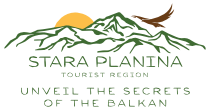The oldest traces of life on the Balkan peninsula were found in the Bacho Kiro cave near Dryanovo. Homo sapiens settled for the first time in this cave potentially 46,940 years ago. This means that homo sapiens had come to Europe several milleniums earlier than it was believed so far.
The Wulfila Bible, also known as the Gothic Bible, is the oldest written document, a translation from Greek into the newly created Gothic alphabet. The translation was made in Nicopolis ad Istrum by Bishop Wulfila. Nowadays the Bible is stored in Sweden.
The final battle between the rebel army of Asenevtsi and Byzantine was fought in 1187 in the medieval Lovech Fortress. The signed peace treaty marked the recognition of the Second Bulgarian State. The Lovech fortress is among the last ones conquered during the Ottoman invasion.
The Serbian priest, educational functionary, and a diplomat Saint Sava died in 1236 in Tarnovo – the capital of the Second Bulgarian kingdom. Initially, he was buried in the Forty Holy Martyrs church in Tarnovo.
The Tarnovo Gospels of Tsar Ivan Alexander were written in 1355-56 by the priest Simon on the order of the Tsar. It is a Bulgarian manuscript-transcript of the Gospels of Matthew, Marco, Luka and John the Theologian, consisting of 268 parchment sheets, 366 miniatures in different colours and gold. The Gospels of Tsar Ivan Alexander is a part of the treasures of the British Library. Due to its value, the public access to the book is limited. The manuscript provides important data about the history of the Slavonic medieval text of the Gospels.
The Monument of Januarius MacGahan (famous traveller from the recent past) is located in Elena - After the suppression of the April Uprising (1876), he did invaluable work in defending Bulgarian people. As a correspondent of the Daily News newspaper, Januarius MacGahan, together with the secretary of the United States delegation and the General Council in Tsarigrad, Eugene Skyper, visited the uprising Bulgarian settlements.
In 1934, on St. Nicholas Mount, the Monument of Freedom was built, accessible via an automobile road and stone stairs. The monument is part of the Shipka Park Museum. The mount symbolizes the heroism and self-sacrificing efforts for the liberation of Bulgaria from Ottoman rule.
During World War II, after the great bombing over Sofia on 10 January 1944, the Saint Kliment Ohridski University in Sofia was evacuated in Lovech.
In the beginning of the 20th century, the Vratsa tourists established a modern tradition in celebrating Christmas Eve. In 1926, the Christmas Eve was celebrated by citizens not in their homes, but in the hall of the newly built Tourist House. This new tradition which was quickly spread among the enthusiastic followers of the Vratsa tourist company, was started with one unique in concept "Bulgarian Christmas Eve."
In 1981, the Buzludzha Monument was opened (official name Home Monument of the Bulgarian Communist Party) and the popular name of the biggest ideological monument of the Communist regime in Bulgaria. Its construction started in 1974. The building has visual resemblance with the Olympic stadium in Montreal as well as with a building designed in about 1955 by Frank Lloyd Wright for the Greek Orthodox church in the state of Wisconsin, USA.
